Abstract
The peripheral vascular response to severe exercise was studied in 11 healthy conscious dogs instrumented with Doppler ultrasonic flow probes on the mesenteric, renal, and iliac arteries, and miniature pressure gauges in the aorta. The response to severe exercise was restudied in six of these dogs after recovery from a second operation producing complete heart block by the injection of formalin into the atrioventricular (AV) node. Three of these dogs also exercised while their ventricles were paced at rates of 100/min and 200/min. The untethered normal dogs ran at speeds of 15-25 miles/hr behind a mobile recording unit for a distance averaging 1.5 miles, while continuous measurements of arterial blood pressure and blood flow were telemetered and recorded on magnetic tape. Severe exercise in normal dogs increased heart rate from 84 to 259/min, arterial pressure from 89 to 140 mm Hg, flow resistance in the mesenteric and renal beds by 59 and 52% respectively, and iliac blood flow 479% above control, while mesenteric and renal blood flows remained constant and iliac resistance decreased by 73%.
In dogs with complete AV block, severe exercise at speeds of 10-18 miles/hr increased heart rate from 47 to 78/min, mean arterial pressure from 81 to 89 mm Hg, iliac flow 224%, resistance in the renal bed by 273%, and mesenteric bed by 222% while it decreased blood flow in mesenteric and renal beds by 61 and 65% respectively, and iliac resistance by 62%. A similar response occurred during exercise with pacing at 100/min, but when paced at 200/min a more normal exercise response reappeared. Thus, in normal dogs the peripheral vascular response to severe exercise involved increases in heart rate, arterial pressure and visceral resistance but visceral blood flow did not decrease. In dogs with heart block, where the ability to increase heart rate is severely compromised, compensatory reduction of mesenteric and renal blood flows occurred.
Full text
PDF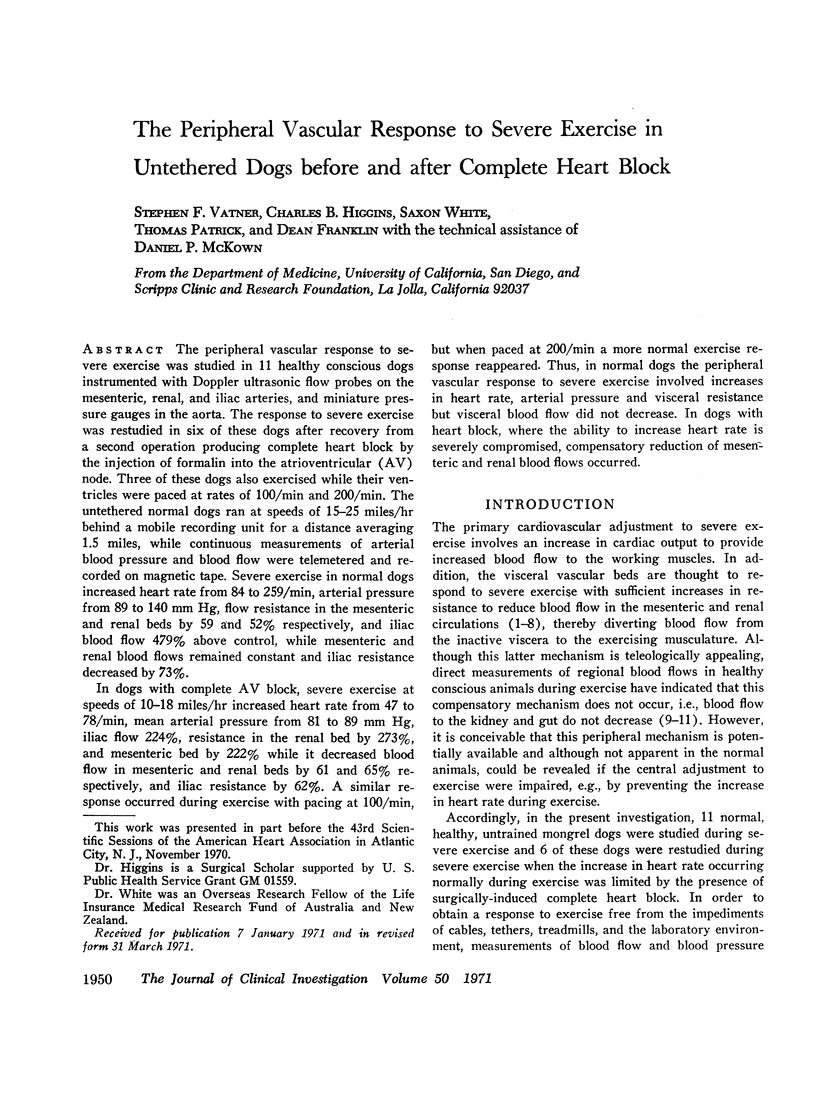
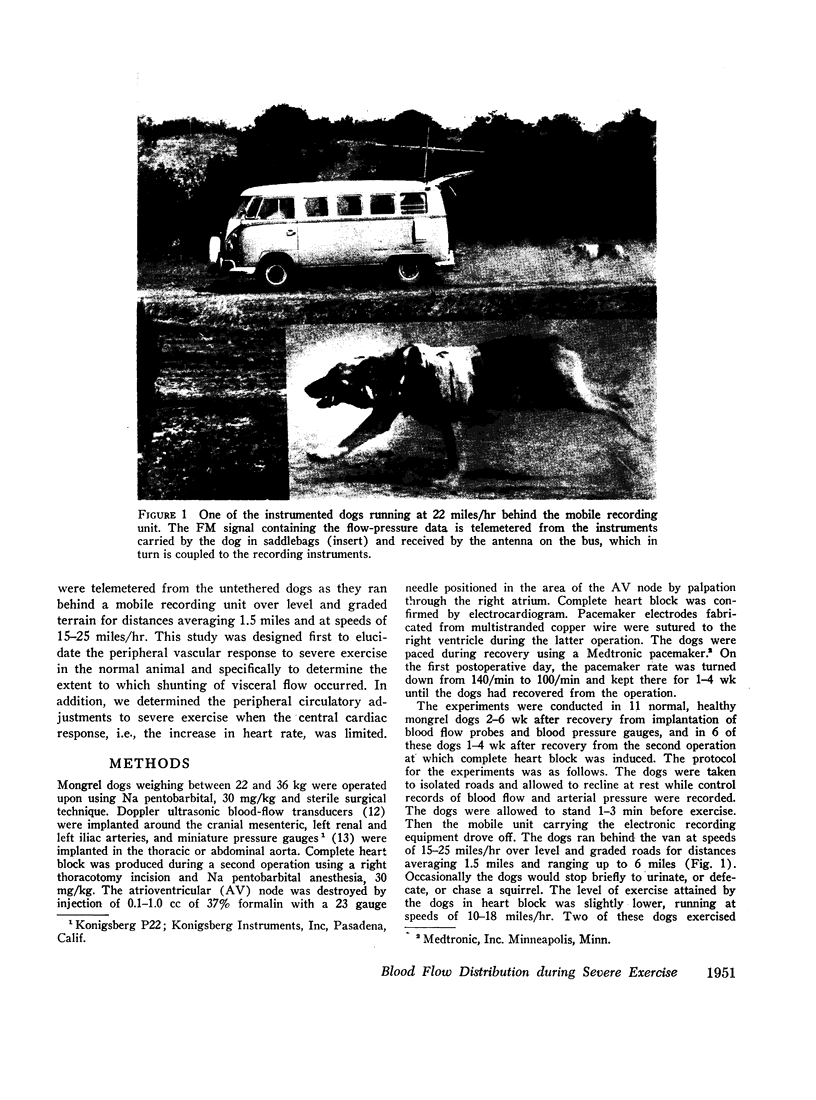
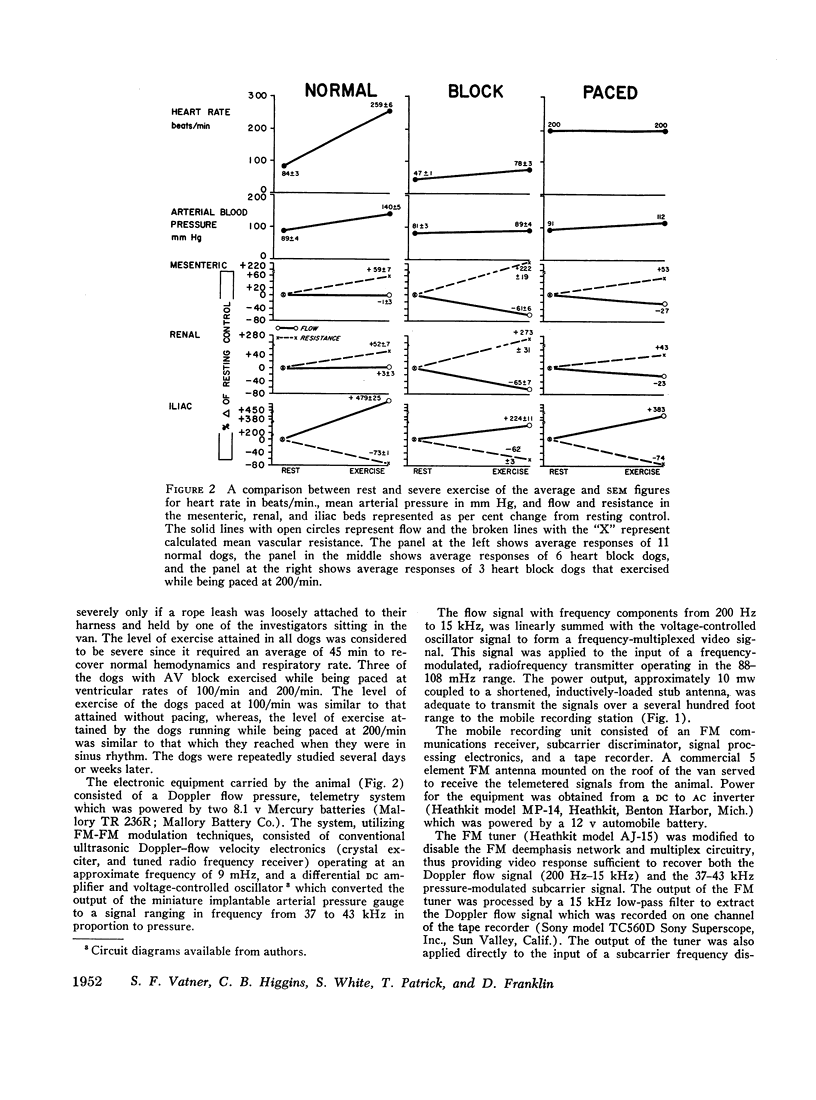
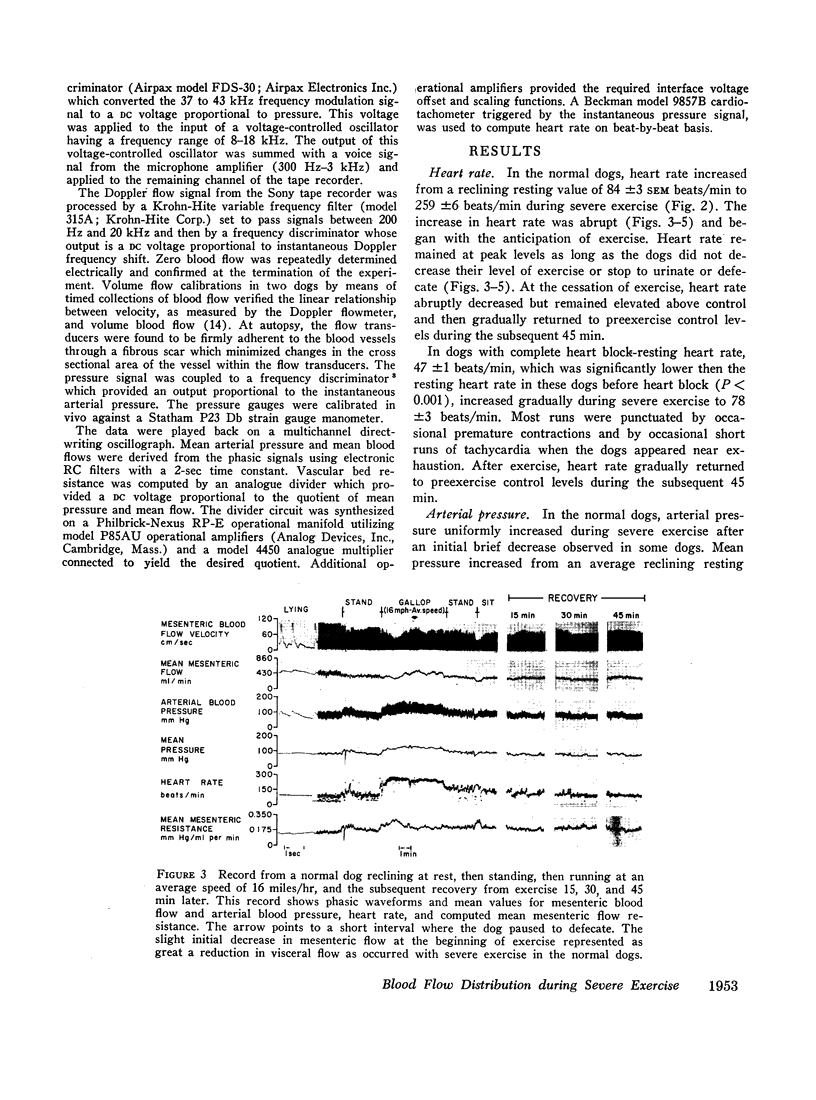

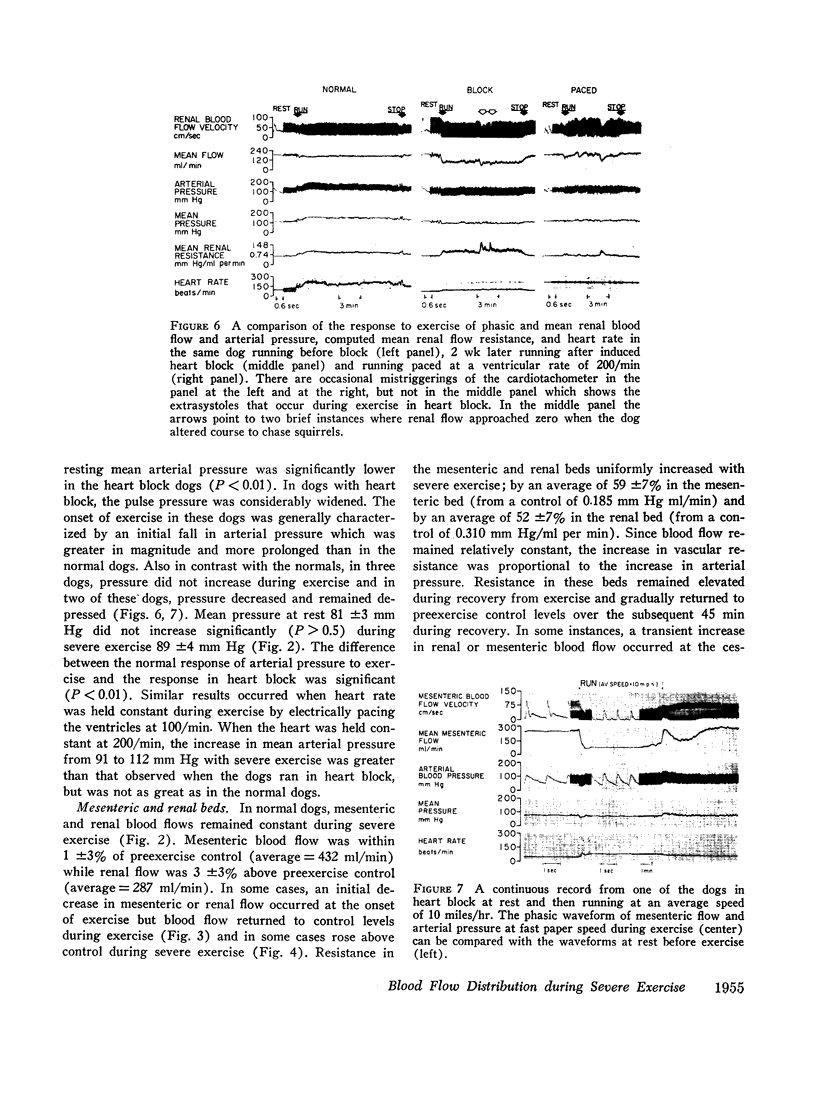
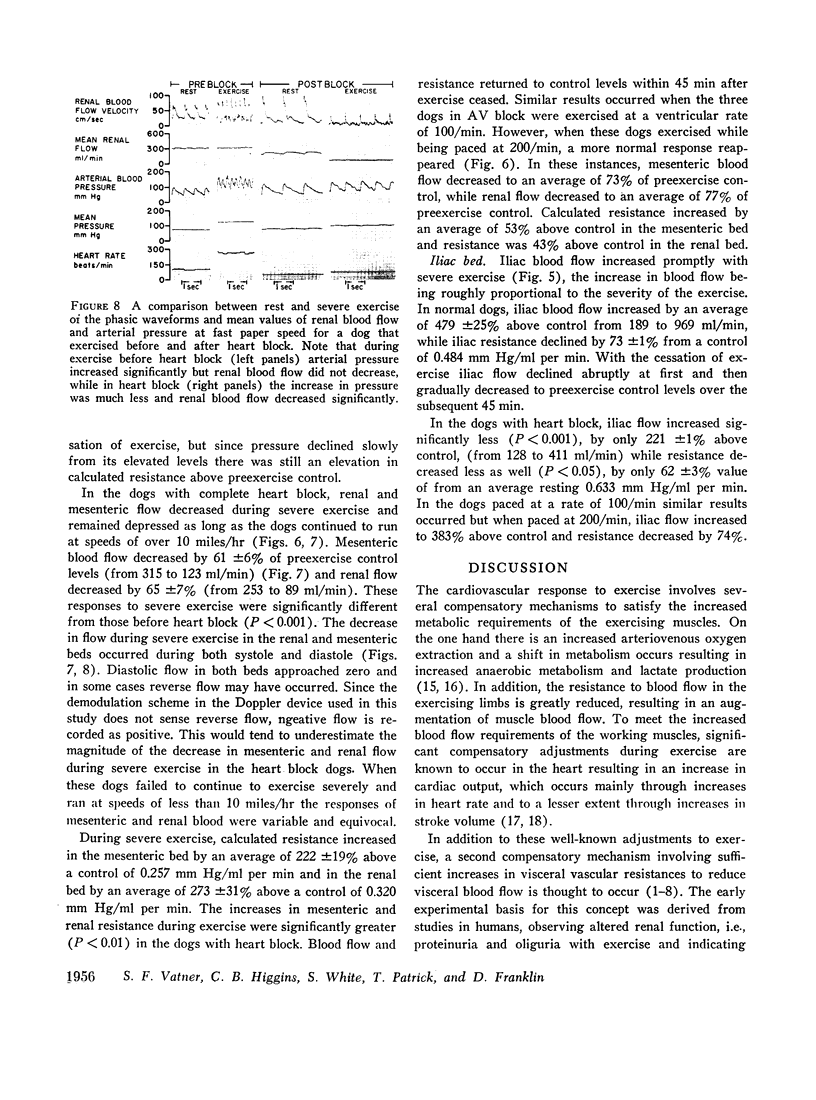
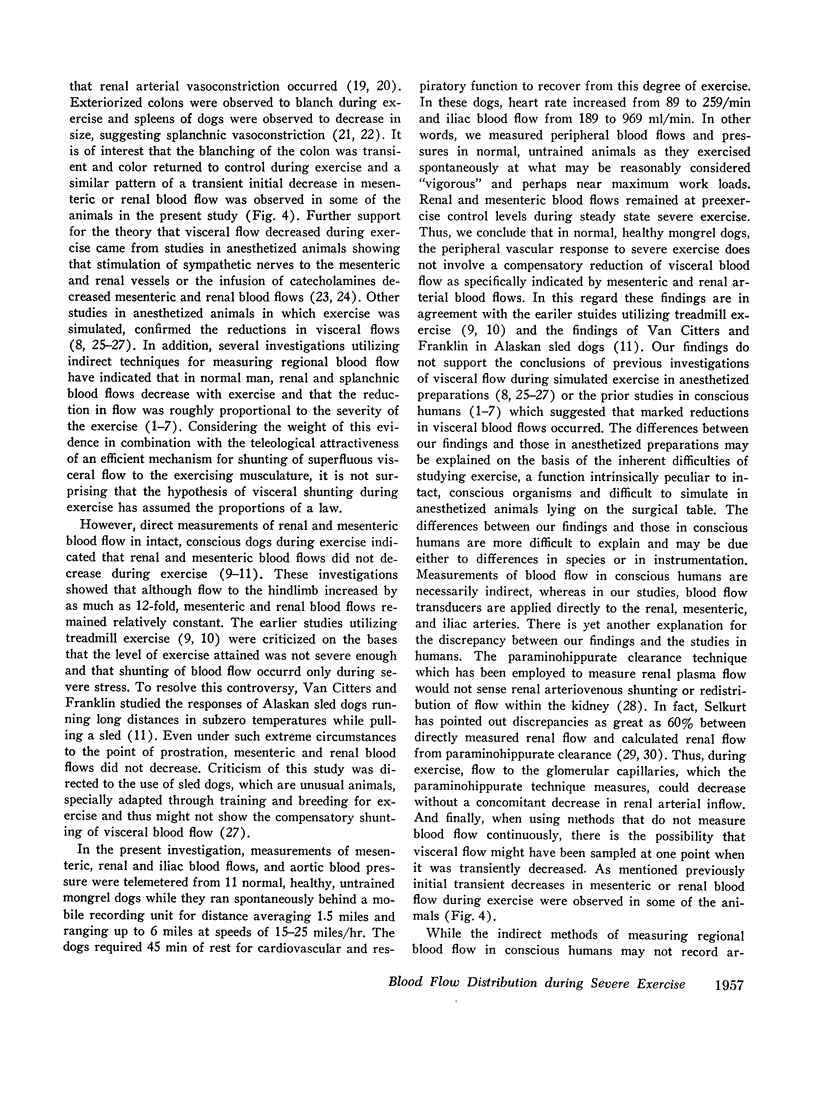
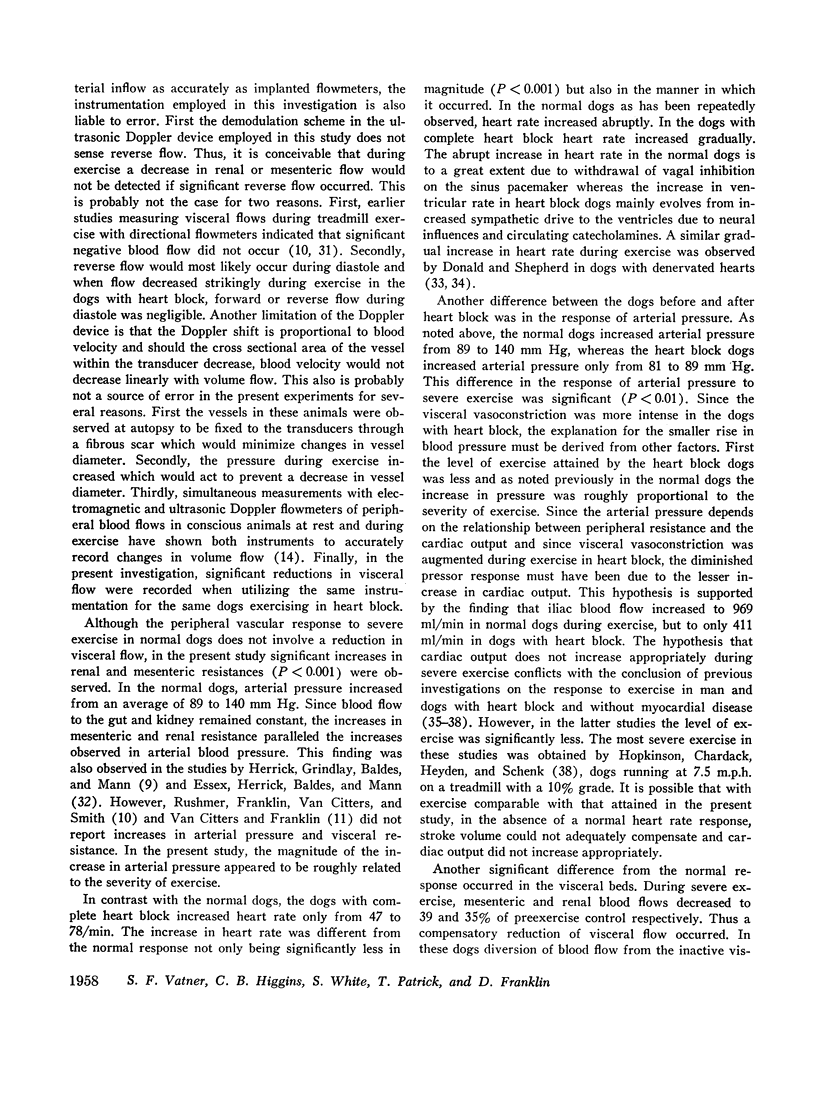
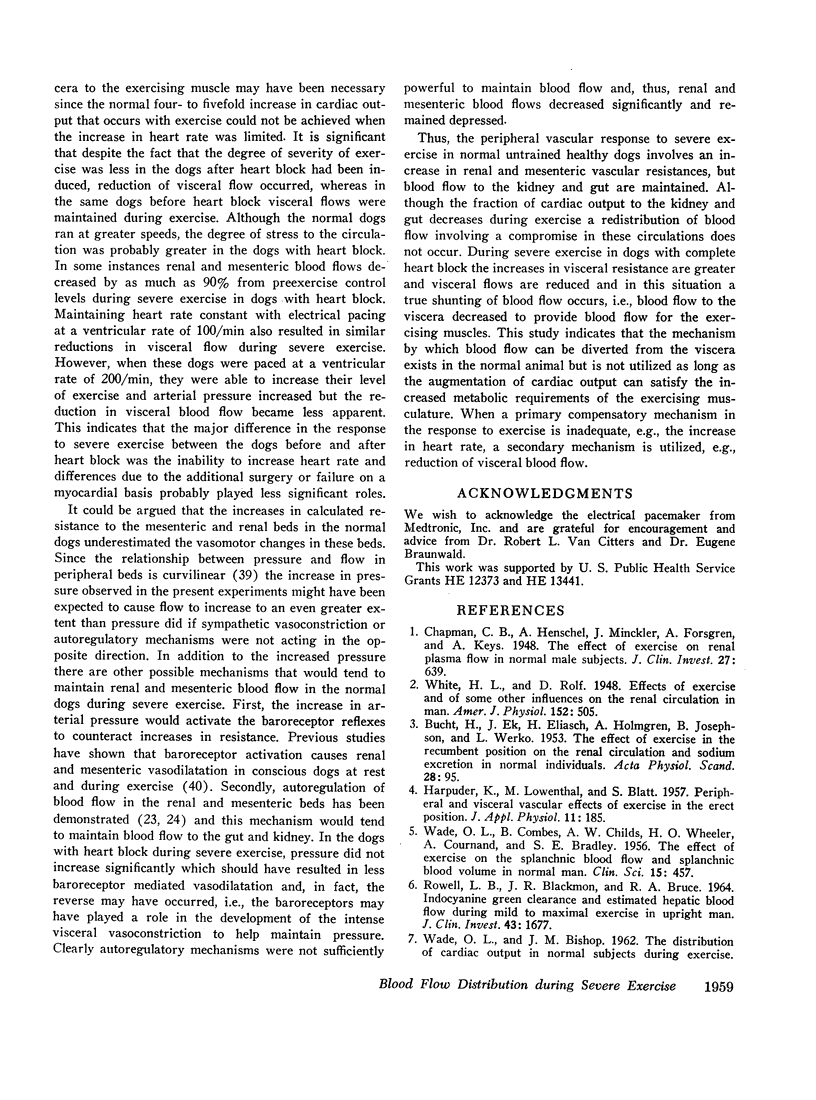
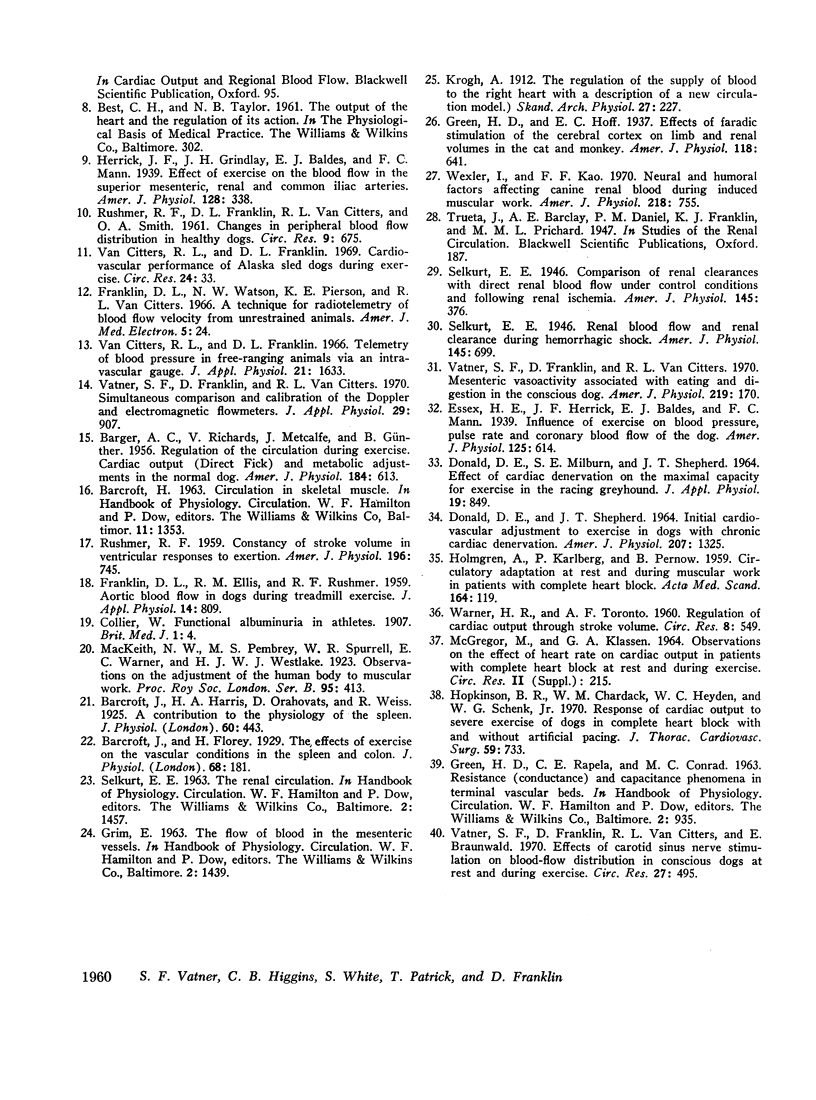
Images in this article
Selected References
These references are in PubMed. This may not be the complete list of references from this article.
- BARGER A. C., RICHARDS V., METCALFE J., GUNTHER B. Regulation of the circulation during exercise; cardiac output (direct Fick) and metabolic adjustments in the normal dog. Am J Physiol. 1956 Mar;184(3):613–623. doi: 10.1152/ajplegacy.1956.184.3.613. [DOI] [PubMed] [Google Scholar]
- BRADLEY S. E., CHILDS A. W., COMBES B., COURNAND A., WADE O. L., WHEELER H. O. The effect of exercise on the splanchnic blood flow and splanchnic blood volume in normal man. Clin Sci. 1956 Aug;15(3):457–463. [PubMed] [Google Scholar]
- BUCHT H., EK J., ELIASCH H., HOLMGREN A., JOSEPHSON B., WERKO L. The effect of exercise in the recumbent position on the renal circulation and sodium excretion in normal individuals. Acta Physiol Scand. 1953;28(2-3):95–100. doi: 10.1111/j.1748-1716.1953.tb00961.x. [DOI] [PubMed] [Google Scholar]
- Barcroft J., Florey H. The effects of exercise on the vascular conditions in the spleen and the colon. J Physiol. 1929 Oct 23;68(2):181–189. doi: 10.1113/jphysiol.1929.sp002605. [DOI] [PMC free article] [PubMed] [Google Scholar]
- Barcroft J., Harris H. A., Orahovats D., Weiss R. A contribution to the physiology of the spleen. J Physiol. 1925 Oct 31;60(5-6):443–456. doi: 10.1113/jphysiol.1925.sp002261. [DOI] [PMC free article] [PubMed] [Google Scholar]
- Chapman C. B., Henschel A., Minckler J., Forsgren A., Keys A. THE EFFECT OF EXERCISE ON RENAL PLASMA FLOW IN NORMAL MALE SUBJECTS. J Clin Invest. 1948 Sep;27(5):639–644. doi: 10.1172/JCI102011. [DOI] [PMC free article] [PubMed] [Google Scholar]
- DONALD D. E., MILBURN S. E., SHEPHERD J. T. EFFECT OF CARDIAC DENERVATION ON THE MAXIMAL CAPACITY FOR EXERCISE IN THE RACING GREYHOUND. J Appl Physiol. 1964 Sep;19:849–852. doi: 10.1152/jappl.1964.19.5.849. [DOI] [PubMed] [Google Scholar]
- DONALD D. E., SHEPHERD J. T. INITIAL CARDIOVASCULAR ADJUSTMENT TO EXERCISE IN DOGS WITH CHRONIC CARDIAC DENERVATION. Am J Physiol. 1964 Dec;207:1325–1329. doi: 10.1152/ajplegacy.1964.207.6.1325. [DOI] [PubMed] [Google Scholar]
- FRANKLIN D. L., ELLIS R. M., RUSHMER R. F. Aortic blood flow in dogs during treadmill exercise. J Appl Physiol. 1959 Sep;14:809–812. doi: 10.1152/jappl.1959.14.5.809. [DOI] [PubMed] [Google Scholar]
- Franklin D. E., Watson N. W., Pierson K. E., Van Citters R. L. Technique for radio telemetry of blood-flow velocity from unrestrained animals. Am J Med Electron. 1966;5(1):24–28. [PubMed] [Google Scholar]
- HARPUDER K., LOWENTHAL M., BLATT S. Peripheral and visceral vascular effects of exercise in the erect position. J Appl Physiol. 1957 Sep;11(2):185–188. doi: 10.1152/jappl.1957.11.2.185. [DOI] [PubMed] [Google Scholar]
- HOLMGREN A., KARLBERG P., PERNOW B. Circulatory adaptation at rest and during muscular work in patients with complete heart block. Acta Med Scand. 1959 Jun 6;164(2):119–130. doi: 10.1111/j.0954-6820.1959.tb00170.x. [DOI] [PubMed] [Google Scholar]
- Hopkinson B. R., Chardack W. M., Heyden W. C., Schenk W. G., Jr Response of cardiac output to severe exercise of dogs in complete heart block with and without artificial pacing. J Thorac Cardiovasc Surg. 1970 May;59(5):733–739. [PubMed] [Google Scholar]
- MCGREGOR M., KLASSEN G. A. OBSERVATIONS ON THE EFFECT OF HEART RATE ON CARDIAC OUTPUT IN PATIENTS WITH COMPLETE HEART BLOCK AT REST AND DURING EXERCISE. Circ Res. 1964 Nov;15:SUPPL 2–2:224. [PubMed] [Google Scholar]
- ROWELL L. B., BLACKMON J. R., BRUCE R. A. INDOCYANINE GREEN CLEARANCE AND ESTIMATED HEPATIC BLOOD FLOW DURING MILD TO MAXIMAL EXERCISE IN UPRIGHT MAN. J Clin Invest. 1964 Aug;43:1677–1690. doi: 10.1172/JCI105043. [DOI] [PMC free article] [PubMed] [Google Scholar]
- RUSHMER R. F. Constancy of stroke volume in ventricular responses to exertion. Am J Physiol. 1959 Apr;196(4):745–750. doi: 10.1152/ajplegacy.1959.196.4.745. [DOI] [PubMed] [Google Scholar]
- RUSHMER R. F., FRANKLIN D. L., VAN CITTERS R. L., SMITH O. A. Changes in peripheral blood flow distribution in healthy dogs. Circ Res. 1961 May;9:675–687. doi: 10.1161/01.res.9.3.675. [DOI] [PubMed] [Google Scholar]
- Van Citters R. L., Franklin D. L. Cardiovascular performance of Alaska sled dogs during exercise. Circ Res. 1969 Jan;24(1):33–42. doi: 10.1161/01.res.24.1.33. [DOI] [PubMed] [Google Scholar]
- Van Citters R. L., Franklin D. L. Telemetry of blood pressure in free-ranging animals via an intravascular gauge. J Appl Physiol. 1966 Sep;21(5):1633–1636. doi: 10.1152/jappl.1966.21.5.1633. [DOI] [PubMed] [Google Scholar]
- Vatner S. F., Franklin D., Van Citters R. L., Braunwald E. Effects of carotid sinus nerve stimulation on blood-flow distribution in conscious dogs at rest and during exercise. Circ Res. 1970 Oct;27(4):495–503. doi: 10.1161/01.res.27.4.495. [DOI] [PubMed] [Google Scholar]
- Vatner S. F., Franklin D., Van Citters R. L. Mesenteric vasoactivity associated with eating and digestion in the conscious dog. Am J Physiol. 1970 Jul;219(1):170–174. doi: 10.1152/ajplegacy.1970.219.1.170. [DOI] [PubMed] [Google Scholar]
- Vatner S. F., Franklin D., VanCitters R. L. Simultaneous comparison and calibration of the Doppler and electromagnetic flowmeters. J Appl Physiol. 1970 Dec;29(6):907–910. doi: 10.1152/jappl.1970.29.6.907. [DOI] [PubMed] [Google Scholar]
- WARNER H. R., TORONTO A. F. Regulation of cardiac output through stroke volume. Circ Res. 1960 May;8:549–552. doi: 10.1161/01.res.8.3.549. [DOI] [PubMed] [Google Scholar]
- Wexler I., Kao F. F. Neural and humoral factors affecting canine renal blood flow during induced muscular work. Am J Physiol. 1970 Mar;218(3):755–761. doi: 10.1152/ajplegacy.1970.218.3.755. [DOI] [PubMed] [Google Scholar]









